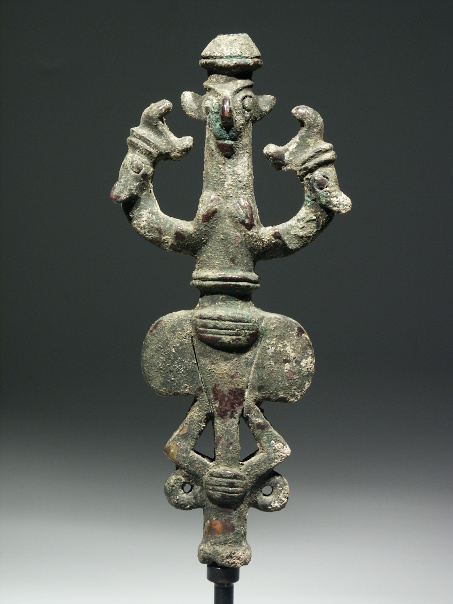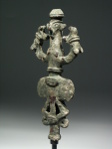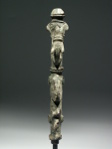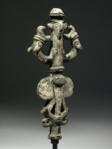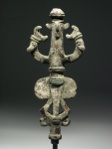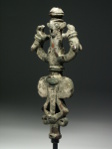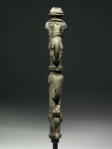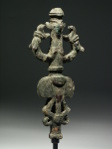Description:
A beautifully made finial or standard top, which in ancient times would have been joined to a standard, a pole or other support. The finial has the form of an anthropomorphic tube which on either side depicts the stylized face of a human or - more likely - of a god, with an elongated nose, large ears and large round eyes; although on similar standards it is often impossible to tell whether it is a male or female creature (see Moorey 1971, p. 153-154), in this case it could be a female, if two details above the arms are indeed intended to depict breasts. On either side of the figure we see the gaping mouth of a predator or a demonic creature, the throat of which the figure is holding in its hands. The lower part of the body of the figure seems to be that of an animal, with crooked legs resting on what could be the stylized head of another animal.
But at the same time, in an almost modern way, the image could be that of two predators, their animal bodies seen from the side, with their paws on the lower part of the tube, and their heads on long curving necks on either side of the central face.
The whole object depicts a scene of long-standing significance in ancient Near Eastern art, a scene which has often be called (confusingly, see Moorey 1971, p.154) the "Master of the Animals".
It is not known with certainty how such standards were used, but attention has been drawn to the fact that this type of object has only been found in graves, which may be significant.
The object comes from the collection of Dr. Arthur M. Sackler (1913-1987), who made a fortune in pharmaceuticals and who owned a fabulous collection of art and antiquities. The Arthur M. Sackler Foundation has published eleven scholarly catalogues of the Arthur M. Sackler collections (Bronzes of the Eastern Eurasian Steppes; Iranian Ceramics; Shang Ritual Bronzes; Western Zhou Ritual Bronzes; Eastern Zhou Ritual Bronzes; Art of Costa Rica: Pre-Columbian Painted and Sculpted Ceramics; Art of the Andes: Pre-Columbian Sculptured and Painted Ceramics; Art from Ritual: Ancient Chinese Bronze Vessels; Finger Prints of the Artist: European Terra-Cotta Sculpture; Piranesi Drawings and Etchings; Studies in Connoisseurship: Chinese Paintings).
Dr. Sackler was a philanthropist and benefactor of the arts. He established several medical institutions which now bear his name. There are also several museums or halls or galleries in major museums bearing his name (Arthur M. Sackler Museum at Harvard University in Cambridge, Massachusetts; Arthur M. Sackler Museum of Art and Archaeology at Peking University, Beijing; Arthur M. Sackler Gallery of Art in the National Museums of Asian Art at the Smithsonian Institution in Washington D.C.; Arthur M. Sackler Stone Sculpture Gallery in the the Metropolitan Museum of Art; the Jillian & Arthur M. Sackler Wing at the Royal Academy, London). He also endowed galleries at Princeton University. Similarly his brothers Mortimer and Raymond endowed many institutions which now bear their names (for example the Sackler Library at the Bodleian Library, University of Oxford, England; the Raymond and Beverly Sackler Gallery, British Museum, London).
Literature:
Houshang Mahboubian, The Art of Ancient Iran: Copper and Bronze (London, Philip Wilson Publishers, 1997), p. 125-163, nos. 105-167;
P.R.S. Moorey a.o., Ancient Bronzes, Ceramics and Seals: The Nasli M. Heeramaneck Collection of Ancient Near Eastern, Central Asiatic, and European Art (Los Angeles, Los Angeles County Museum of Art, 1981), p. 55;
P.R.S. Moorey, Catalogue of the Ancient Persian Bronzes in the Ashmolean Museum (Oxford, Clarendon Press, 1971), p. 140-160, nos.161-184, pls. 30-37, esp. p. 153 ff., nos. 175 ff.;
Phil Watson, Luristan Bronzes in Birmingham Museum and Art Gallery (Birmingham, Birmingham Museums & Art Gallery, 2011), p. 2-11, nos. 1-17;
Oscar White Muscarella, Bronze and Iron. Ancient Near Eastern Artifacts in the Metropolitan Museum of Art (New York, Metropolitan Museum of Art, 1988), p. 136-154.
Dating:
Circa 9th-7th century B.C.
Size:
Height 12.7 cm.
Provenance:
Collection of Arthur M. Sackler (1913-1987); acquired 1970.
Condition:
In very good condition, with a green and brown patina.
Price:
€ 2,200
Stock number:
A0814

